Introduction
Tibetan Buddhism is structured on the notion of ‘transmission’, the passing on of teachings and methods from the teacher to the student – who in his turn hands on the teachings to his own students. This has given rise to a number of ‘lineages’; lines of descent of dharma wisdom from one great master to the next. These masters are often ‘reincarnate lamas’, with alternate ‘lineage-holders’ holding the transmission during the period from the death of the reincarnate to the coming of age of his next incarnation.
The Karma Kagyu school of Tibetan Buddhism is an example of one such lineage. The Karmapa, who first incarnated in the 12th century and is now in his 17th incarnation, is a treasury of teachings; his lineage-holders – reincarnates themselves – are the Shamar, Tai Situ, Jamgon Kontrul and Gyaltsap Rinpoches.
This is sometimes called the Whispering Lineage, not because the master literally whispered the teaching to his pupil, but rather in reference to the continual verbal transmission to a select number of high calibre students.
The Karma Kagyu Lineage is the Yogic transmission among the four main schools of Tibetan Buddhism. It encompasses both the old (Nyingma) and the new (Sarma) teachings which reached Tibet. Being heavily practice oriented, the Kagyu is called the “oral” or the “perfection” school. The origin of the Kagyu Lineage dates back to the ninth century at the time of the full flowering of Tantric Buddhism in India. The first teacher in this tradition was Tilopa, the renowned yogi and Mahasiddha (perfected one). Tilopa received the transmission directly from Dorje Chang (skt.: Vajradhara), the celestial Buddha who symbolizes the Dharmakaya, the ultimate mind. Tilopa in turn gave the whispered teachings to Naropa who had previously been chancellor of Nalanda University in India. Naropa’s twelve years of service to Tilopa are regarded as a great example of devotion to one’s teacher.
The first Tibetan to receive the teaching was Marpa, the Translator, so named because of his heroic efforts to reach India on foot, searching for his teacher Naropa, and patiently practicing and translating the Mahamudra teachings into Tibetan. Marpa was a householder and landowner and he gathered around him a number of students; the main one was Milarepa. Because of the bad karma acquired through his early deeds as a sorcerer, Milarepa was submitted to years of arduous purifying labor before Marpa would grant him the teachings. Milarepa spent many years meditating in caves, gained profound illumination and was famed as a poet and saint. He died at the age of 80, at which time the lineage passed onto Gampopa who had previously been a doctor. Gampopa was the first monk of the Kagyu School and he organized the Kagyu monastic system. He also formulated the teaching in practical texts such as the “Jewel Ornament of Liberation” which outlines the gradual path to liberation.
Four major and eight minor schools originated from Gampopa’s three main disciples. The major schools have all fused into the Karma Kagyu with the Karmapa as the head. The first Karmapa, Dusum Chenpa, was Gampopa’s most gifted disciple. He manifested great spiritual power and purity early in his life and in his sixteenth year he received a supernatural Black Crown from dakinis and other divinities which bestowed knowledge of the past, present and future. This hat has been passed on to all the subsequent Karmapas who are reincarnations or “tulkus” of Dusum Chenpa. All the Karmapas have worked unceasingly to spread the Buddha’s teaching, and are recognized as emanations of the bodhisattva Chenrezig (skt.: Avalokitesvara).
Buddha Sakyamuni

Gautama taught a Middle Way between sensual indulgence and the severe asceticism found in the Sramana (renunciation) movement common in his region. He later taught throughout regions of eastern India such as Magadha and Kosala.
Dorje Chang – Vajradhara
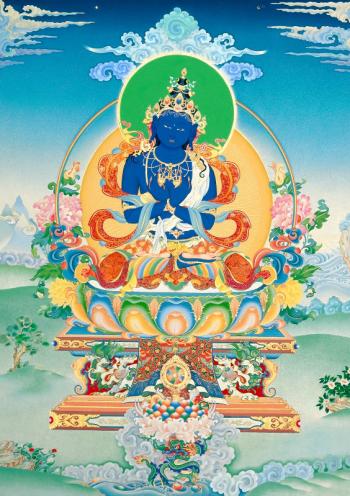
Tilopa (988-1069)

Tilopa profited from his expulsion by travelling throughout India, searching out many teachers, and learning their methods. He earnt his living during this period by grinding sesame seeds (‘Til’ in Sanskrit) for oil – giving him the name by which we know him today. He was given direct transmission of the Mahamudra and other teachings, by the Buddha Vajradhara (Tib. Dorje Chang), who became his root guru. Although he chose to live in remote and inhospitable regions, his fame as a meditation master brought him excellent students, from whom he selected Naropa as the lineage holder.
Naropa (1016-1100)
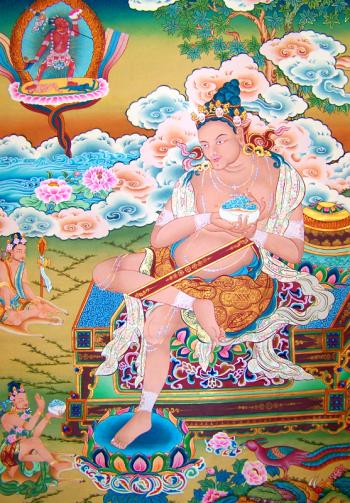
Meanwhile his parents, according to the custom of the time, had arranged for his marriage to Vimaladipi, a Brahmin. The ceremony took place upon his return, but eight years later Naropa insisted on its dissolution, and promptly returned to Kashmir to be ordained and to undertake further study.
Several years later, at twenty-eight, his interests drew him to Nalanda University, near Pullahari, famous for its Buddhist philosophers, and of which he became Abbot in due course. But then a dakini appeared to him, telling him that meditation practice was more important than philosophizing, and that he should search out a certain Tilopa for instructions. Abandoning his vows, Naropa set out to the East to find this teacher – often seen paired with Naropa in thangkas. He did eventually meet Tilopa, without recognizing him, and was put to twelve gruelling tests. He persevered, however, mastered Tilopa’s teachings, and took disciples of his own.
Marpa Chokyi Lodro (1012-1096)

Djetsun Milarepa (1052-1135)

Milarepa’s reward was to suffer years of testing at his master’s hands. Among other trials, he built a nine-story tower, to Marpa’s specifications. But finally, Marpa gave Milarepa full transmission of all he had learnt from Naropa and other Indian masters. Practicing these teachings for many years, Milarepa attained enlightenment, and gained fame for his songs. Of his own students, Gampopa became his lineage-holder.
Gampopa Sonam Rinchen (1079-1153)
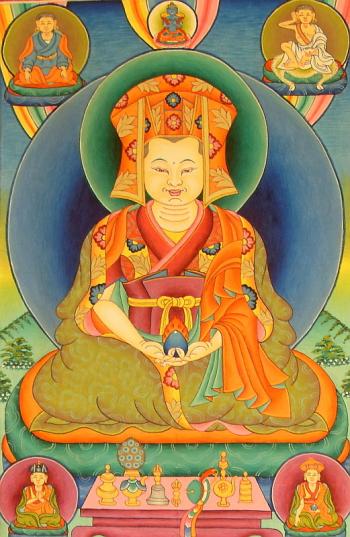
1. Karmapa – Dusum Khyenpa (1110-1193)
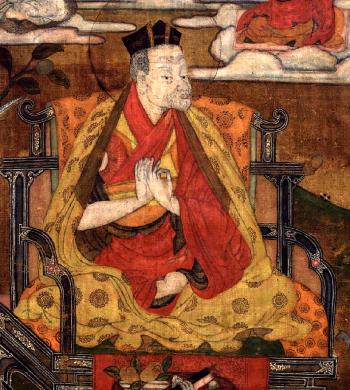
16. Karmapa – Rangjung Rigpe Dorje (1924-1981)
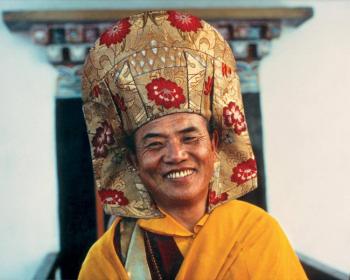
The sixteenth Karmapa, Rangjung Rigpe Dorje (1924-1981), was born at Denkhok in Derge province in east Tibet. Jampal Tsultrim, the fifteenth Karmapa’s personal attendant, had been entrusted by his master with a letter setting forth the circumstances of his new incarnation. Jampal Tsultrim now handed this letter to the authorities at Tsurphu monastery, who – having had Beru Khyentse, Situpa and Jamgon Kontrul clarify certain points – sent out the search-party which successfully located the child. He was taken to Palpung Monastery where Situ Pema Wangchok gave him ordination, bodhisattva vows, and many teachings. In addition, Beru Khyentse Lodro Mizat Pampa’i Gocha taught him the Tantra, Bo Kangkar Rinpoche taught him the sutras, and Jamgon Palden Kyentse Oser taught him Mahamudra and the Six Yogas of Naropa. He would come to regard Situ Pema Wangchok and Jamgon Palden Kyentse Oser as his main gurus.
His life took on the pattern of his predecessors, travelling and teaching throughout the country. But then political circumstances intervened, with the 1950 take-over of Tibet by the Chinese. The Dalai Lama, with government officials and many high lamas, including the sixteenth Karmapa, attended talks in Beijing, in the hope of negotiating a settlement. The discussions were successful in buying some time for the Tibetan people, but in 1959 the Chinese proceeded to annex Tibet, at which point the Karmapa fled to India.
The King of Sikkim, Tashi Namgyal, offered the Karmapa land, upon which he built Rumtek monastery. He also accepted an invitation to come to Bhutan by their King, Jigme Dorje Wangchuk. He travelled to Ladakh, teaching at various monasteries, before going on pilgrimage to holy sites in India and Nepal. His travels continued to broaden in his efforts to spread the dharma; in 1974 he came to the West for the first time, as dharma centers were established world-wide, and he attracted an increasing number of followers.
17. Karmapa – Trinle Thaye Dorje
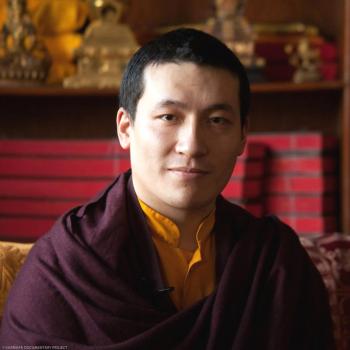
Having escaped from Chinese-controlled Tibet in 1994, His Holiness Karmapa has lived in New Delhi and Kalimpong for many years. He travels extensively throughout India, attending significant events such as the Kagyu Mönlam in Bodh Gaya each year, teaching and granting empowerments to students.
He has also visited many countries in Asia and Europe, as well as Russia, starting with giving empowerments to thousands of students in Taiwan and Singapore in 1999 and continuing actively to this day.
His formal education was completed in 2003, at which time he received the title of Vajracharya, or Great Tantric Master.
His Holiness Karmapa has the spiritual responsibility for over 900 monasteries and meditation centres worldwide, including the Karmapa International Buddhist Institute (KIBI), which runs courses in Buddhist higher education.
Throughout the 2000s, Karmapa Thaye Dorje travelled extensively in Europe and the West, including the USA for the first time in 2003. He has visited the UK three times to date. In 2005 Karmapa Thaye Dorje was the guest of honour at an interfaith reception, hosted by St Ethelburga’s Centre for Peace and Reconciliation, in the presence of the Bishop of London and spiritual leaders from the Hindu, Christian, Jewish, Muslim, Sikh and Jain faiths, where he delivered his keynote speech.
2005 His Holiness visited and blessed our centre Karma Ratna Dargye Ling in Tar.
Venerable Kalu Rinpoche (1905-1989)

Lama Ngawang Rinpoche (1927-2011)

After that, in 1976, Kalu Rinpoche sent him to the West, to Sweden, to spread the holy dharma for the benefit of all living beings. All desciples and all well-intentioned people should know that the goal can be reached if one follows a lama with the right motivation, and generates an unmoveable faith and devotion, studies the dharma, and meditates. It is important to keep all this in mind, because then you will have the chance to reach buddhahood, the state of purity and perfection, for your benefit, and for the benefit of all.
Lama Cultrim Rinpoche
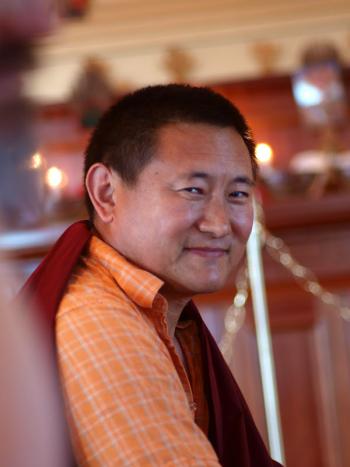
Lama Tsültrim Rinpoche was born in 1968 in Tibet. He completed the traditional 3-year retreat led by Drupon Dechen Rinpoche in the home of Karmapas, in Tsurpu.
After the retreat he was delegated to lead the Jangpachen Monastery, then he was the lama in charge of the meditation center in Singapore for two years. Since 2000, he has been the assistant to and the successor of the Venerable Lama Ngawang at our sister sangha in Sweden.
Venerable Lama Choepel

He completed the traditional 3-year meditation retreat in Sweden. At present, fulfilling Lama Ngawang’s request, he leads three meditation centers in Hungary. He also gives teachings in Sweden, Transylvania, and Slovakia.
He authors numerous books, in which he translated or commented the teachings of the Indian and Tibetan masters of the Inner Path, providing an opportunity for all of us to gain true understanding, and to live our lives according to the practices he teaches.
With his life and dedicated work he is a true follower of his masters.
